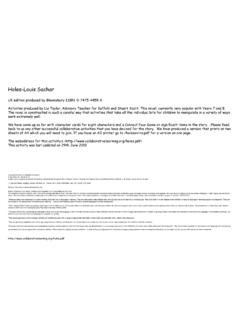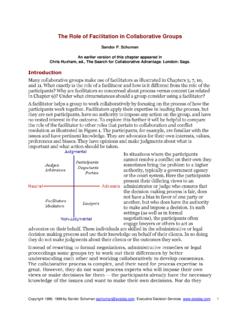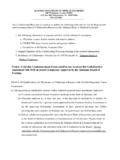Transcription of Collaborative Healthcare Leadership - Executive …
1 A White Paper Collaborative Healthcare Leadership A Six-Part Model for Adapting and Thriving During a Time of Transformative Change By: Henry W. Browning, Deborah J. Torain, and Tracy Enright Patterson Issued September 2011. CONTENTS. 3 Introduction: A Leadership Model for Healthcare Transformation 4 Six Essential Organizational Capabilities 11 The Payoff: A Culture of Collaboration 12 Conclusion 13 About the Model: CCL's Research and Experience 17 Impact Stories 18 Additional Resources 19 About the Authors and Contributors Introduction: A Leadership Model for Healthcare Transformation For decades, hospital administrators and medical professionals have operated within a challenging, rapidly Today, this environment is even more complex as changing and fragmented Healthcare system. sweeping Healthcare reform and market forces transform the way Healthcare is delivered and managed. This profound shift is both structural and cultural.
2 New alliances and unlikely partnerships are beginning to emerge. Belief systems, values and attitudes are shifting. Creative thinking and agile, adaptive Leadership will be required to make hospitals, health systems and networks sustainable as the Healthcare delivery landscape transforms. As this unknown future state unfolds, one thing is a given: Incremental responses will not be enough. The competencies required of leaders and their organizations must continue to evolve in order for both to thrive. Rapid innovation and adaptation to change require a Collaborative , interdependent culture and solutions that cut across function, region and profession. Leaders must learn to shift away from the individual expert model so common in today's Healthcare systems and move towards a model that leverages cross-boundary groups and teams and spans disciplines, levels, functions, generations and professions. These new Collaborative groups will be able to integrate knowledge throughout the system and to anticipate and solve unprece- dented challenges all while delivering efficient, high-quality, compassionate patient care across the continuum.
3 3. The Center for Creative Leadership (CCL ) has developed a model that health systems can use to adapt and thrive in uncertain times by creating direction, alignment and commitment. It is based on multiple research studies, our in-depth involvement with a diverse group of hospital systems and networks and our Leadership development work with thousands of Healthcare leaders from across the sector. Our model focuses on six essential organizational capabilities that are a prerequisite for success in this new world order: 1. Collaborative Patient Care Teams 2. Resource Stewardship 3. Talent Transformation 4. Boundary Spanning 5. Capacity for Complexity, Innovation and Change 6. Employee Engagement and Well-being We've also identified key Leadership practices needed in each of these six areas in order to maximize effec- Healthcare tiveness. Through this Leadership lens, organizations can clarify their business chal- lenges and become highly adaptive and inno- vative in response to change.
4 They can shift their culture and transform the business and mission of Healthcare . In the white paper that follows, you'll find details on CCL's model, as well as the research projects and real-world experiences that have led to its development. Six Essential Organizational Capabilities The successful Healthcare organization of the future will develop and implement a Leadership strategy that systemically addresses priorities and is supported by the Leadership practices needed to achieve organizational goals and to adapt to rapid change and uncertainty. CCL. offers a six-part model Healthcare organizations can use to assess their own Leadership strengths and weakness- es and to customize their Leadership development efforts. In a practical way, it matches up very real needs with the Leadership skills and capabilities that will make the most difference with the common, underlying thread of Collaborative Leadership .
5 Healthcare organizations will, as a result, have the opportunity to approach Leadership development in a strategic, comprehensive way while dealing with real and immediate pressures. As an organi- zation's commitment to collaboration becomes visible and is reinforced, it will see improvements in the ability to set direction, establish alignment and gain commitment. 4. 1 Collaborative Patient Care Teams Delivering safe, quality, compassionate care is the primary mission of any Healthcare organization. Given that roles within the patient-care team are highly interdependent in nature, collaboration skills are crucial. This is especially true in acute care situations involving doctors, nurs- es and the teams they manage. With Healthcare reform, though, the patient-care team will likely extend to include clinicians outside the hospital environment. Accountable care organizations, integrated clinical networks and other new delivery models will place a much greater emphasis on higher-order collaboration skills that go far beyond working well with others.
6 Concrete group process skills are needed to promote open communication, learning, trust and quality decision-making. The While collaboration is important throughout the hospital, it is especially important at the patient interface. ability to ensure patient care is determined not only by technical expertise, but also by the lead- ership effectiveness of all those involved in solving the presenting medical issues. These individu- als are leading the patient-care experience as they foster a new contract for working together. Often, true Leadership is independent of formal roles and responsibilities. It also shifts throughout the patient-care experience. Therefore, effective care depends on Collaborative teamwork. This is especially true between physicians and nurses. While diagnosis and prescription of treatment has traditionally resided with the physician, nurse practi- tioners and physician assistants have increasing responsibility for carrying out the treatment plan.
7 It will be essen- tial that management systems take into account shifting responsibilities over the course of the patient's care. While new structures are evolving, clearly the distribution centers for care are expanding, and who is responsible for impacting the patient's long-term health and well-being is changing. From a Leadership development perspective, the key to tackling these daily team-effectiveness challenges lies in greater employee engagement, collaboration and learning agility. Leadership Practices l Engaging doctors, nurses and other caregivers in shared ownership of the patient-care experience using concrete dialogue and listening skills across roles. l Creating an environment that supports learning agility and adapting to change. l Collaborative problem-solving and decision-making with all members of the patient-care team. 5. 2 Resource Stewardship In an age of increasing accountability, resource stewardship is both a big-picture, system-level obligation and a series of daily decisions.
8 As Healthcare reform unfolds, new business models and restruc- turing will emerge to manage costs while delivering compas- sionate, quality care. On the macro level, Healthcare organiza- tions must look far ahead to understand how the unfolding future impacts their current structures and business models. They urgently need to seek out opportunities to reduce costs. Decisions about investments and partnerships are made knowing that trade-offs will be required. Resource stewardship requires indi- vidual ownership and accountability for the decisions that will ulti- mately allow the system to thrive and manage its resources judiciously. At the micro level, administrators, physicians, nurses and other stakeholders must manage the tension between individual patient care and operational constraints. They need to adapt to new models and structures and be Hospitals need both innovative and visionary in their approach to cost-effective patient-care models.
9 Patient-focused business professionals and business-minded clinicians who can keep patient care top of mind. Only through education and dialogue can comprehensive solutions be reached. Alignment is created when caregivers and business leaders reach a common understanding of the clinical strategy as well as the business strategy. To be effective resource stewards, leaders must have a solid understanding of performance metrics, including financial indicators, employee engagement, patient results and satisfaction. In addition, leaders need to identify key measures, apply data in strategic ways and identify, discuss and resolve problems. Leadership Practices l Accountability, transparency and integrity. l Scanning the environment and seeking innovative solutions. l Appreciating and combining compassionate care needs with business strategy. l Entrepreneurial; generating new ideas and seizing opportunities. 6. 3 Talent Transformation CCL's research shows that Healthcare organizations need visionary leaders who can inspire and develop employees, build and mend relationships effectively, lead and motivate teams, and engage in participative management.
10 In addition to these core competen- cies, new and different Leadership skills will be required to see Healthcare organizations through a change that has not been equaled since Medicaid and Medicare were established. (Jarousse, 2010; Dolon 2010) Leaders of Healthcare systems will need to hire and develop talented individuals who can see the next wave of plausible solutions and innova- tions and lead transformational change. Hospitals and health systems are managing a transitioning workforce. The physician's role is evolving from inde- pendent practitioner to hospital employed collaborator. The roles of Executive nurse leaders are expanding and the responsibilities being elevated. As new staffing models emerge, hospitals still face an ongoing nursing shortage and an aging nurse and physician workforce. (RWJF Committee on the Future of Nursing, 2011; Buerhaus, 2009). As the talent pool shrinks and demands increase, hospital, outpatient and clinical workforces are stretched thin.








